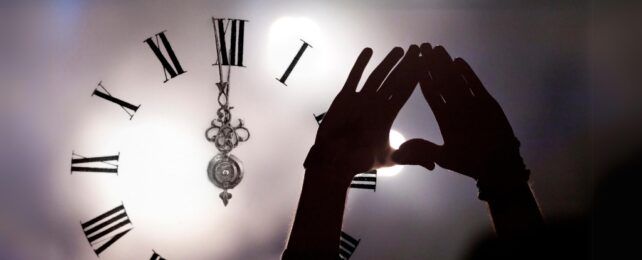The Doomsday Clock, with its hands hovering close to midnight ("doomsday"), is a symbolic device that is designed to warn the world how close it is to catastrophe.
Midnight is said to represent the point at which the Earth becomes uninhabitable by humanity.
The clock dates back to the early days of the cold war. It was set up as an integral feature of a journal called the Bulletin of Atomic Scientists. This was established in 1947 by those Manhattan Project scientists and engineers who were closely linked to the development of the atomic bomb.
They were concerned about "the destroyers of worlds" they had created. Articles in the bulletin were largely devoted – as they still are today – to highlighting the perils of nuclear weapons.
At the beginning of 2023, the hands of the Doomsday Clock were set at a mere 90 seconds to the hour, the closest it has ever been to midnight.
There is no one overall reason for this move. Of course, with climate change now a major factor in the threat to humanity, the clock has to reflect this, and does. But it is, however, other more immediate factors that have largely caused the hands to be pushed forward.
The most significant influence has been the war in Ukraine and particularly the Russian threat of "escalating to de-escalate". This notion has been widely discussed in Russia, including by those with close ties to President Vladimir Putin.
The idea here is that if Russian forces were about to suffer a major defeat in Ukraine, they would use tactical (low-yield) nuclear weapons on the battlefield (that is, to "escalate" the war). This would then create serious pause among those western powers who were supporting Kyiv.
They would, the logic runs, be persuaded into withdrawing that support because they would not want to risk a wider war with Russia that might include the use of strategic nuclear weapons. Moscow would then "win" the war against a Ukraine now lacking western help. The war would be over – hence the "de-escalation".
Beyond what might happen on actual battlefields in Ukraine, rising background tensions between Washington and Moscow have also contributed to the current position of the clock's hands.
The bilateral treaties that once held in check developments in the field of nuclear weapons have now largely gone. The US itself withdrew from the Anti-Ballistic Missile (ABM) Treaty treaty in 2001 and the Intermediate-range Nuclear Forces (INF) treaty in 2019.
And while the end of these agreements would have played their part in the setting of the clock's hands at 90 seconds at the start of 2023, there have been yet further concerning moves actually during 2023.
In February 2023, Russia withdrew from the New Start Treaty and early in November it was announced that it would also withdraw from the Comprehensive Nuclear Test Ban Treaty.
So all of the agreements related to limiting nuclear weapons that, in the past, had moved the hands away from midnight, have now gone.

When the clock started
The clock's hands, since 1947, have been set at the beginning of every year by the bulletin. Originally, the clock was concerned with the threat of an actual nuclear war between the cold war superpowers, the US and the Soviet Union.
Recently, however, the clock has also come to include and reflect the global threat from climate change, which was first included as a factor by the bulletin in 2007.
At various points over the years, the clock has been adjusted to react to world events. In 1947, its original setting was at seven minutes to midnight. It moved up to just two minutes in 1953 when both the US and the Soviet Union tested their new, and more destructive, hydrogen bombs.
The clock, though, never moved as close again to midnight throughout the rest of the cold war.
Whenever the hands were moved forward, they tended to be brought back again later to reflect any warming of relations between Washington and Moscow – such as with the detente of the early 1970s or following the signing of various arms limitation agreements.
These agreements would include the likes of the Partial Nuclear Test Ban Treaty of 1963, the Strategic Arms Limitation Talks (Salt) of the 1960s and 1970s, the ABM treaty of 1972, the INF agreement of 1987, the Strategic Arms Reduction Treaty (Start I) of 1991, and the follow-on New Start of 2010.
Indeed, in 1991, and in the halcyon days – in tension-reduction terms – of the immediate post-cold war period, the Doomsday Clock's hands were moved further away from the midnight hour than at any point since 1947: they stood at a comforting 17 minutes.
In 2023, the world, it seems – and if the Doomsday Clock is to be treated with credence – is not in a good place. But this clock is, though, a warning device, albeit symbolic.
As such, it can hopefully serve to concentrate minds and to bring to bear wise counsels who can act to avert the catastrophe (whether nuclear- or climate-induced) that the clock's founders had designed it to prevent.![]()
Rod Thornton, Associate Professor/Senior Lecturer in International Studies, Defense and Security., King's College London
This article is republished from The Conversation under a Creative Commons license. Read the original article.
